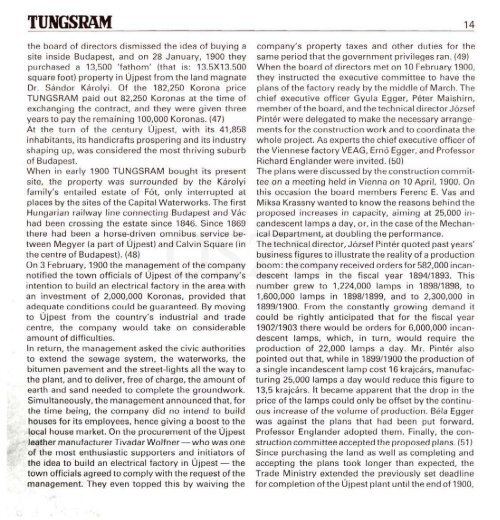THE HISTORY OF TUNGSRAM 1896-1945 - MEK
THE HISTORY OF TUNGSRAM 1896-1945 - MEK
THE HISTORY OF TUNGSRAM 1896-1945 - MEK
- No tags were found...
You also want an ePaper? Increase the reach of your titles
YUMPU automatically turns print PDFs into web optimized ePapers that Google loves.
<strong>TUNGSRAM</strong> 14the board of directors dismissed the idea of buying asite inside Budapest, and on 28 January, 1900 theypurchased a 13,500 'fathom' (that is: 13.5X13.500square foot) property in Ujpest from the land magnateDr. Sandor Karolyi. Of the 182,250 Korona price<strong>TUNGSRAM</strong> paid out 82,250 Koronas at the time ofexchanging the contract, and they were given threeyears to pay the remaining 100,000 Koronas. (47)At the turn of the century Ujpest, with its 41,858inhabitants, its handicrafts prospering and its industryshaping up, was considered the most thriving suburbof Budapest.When in early 1900 <strong>TUNGSRAM</strong> bought its presentsite, the property was surrounded by the Karolyifamily's entailed estate of Fot, only interrupted atplaces by the sites of the Capital Waterworks. The firstHungarian railway line connecting Budapest and Vachad been crossing the estate since 1846. Since 1869there had been a horse-driven omnibus service betweenMegyer (a part of Ujpest) and Calvin Square (inthe centre of Budapest). (48)On 3 February, 1900 the management of the companynotified the town officials of Ujpest of the company'sintention to build an electrical factory in the area withan investment of 2,000,000 Koronas, provided thatadequate conditions could be guaranteed. By movingto Ujpest from the country's industrial and tradecentre, the company would take on considerableamount of difficulties.In return, the management asked the civic authoritiesto extend the sewage system, the waterworks, thebitumen pavement and the street-lights all the way tothe plant, and to deliver, free of charge, the amount ofearth and sand needed to complete the groundwork.Simultaneously, the management announced that, forthe time being, the company did no intend to buildhouses for its employees, hence giving a boost to thelocal house market. On the procurement of the Ujpestleather manufacturer Tivadar Wolfner — who was oneof the most enthusiastic supporters and initiators ofthe idea to build an electrical factory in Ujpest — thetown officials agreed tocomply with the request of themanagement. They even topped this by waiving thecompany's property taxes and other duties for thesame period that the government privileges ran. (49)When the board of directors met on 10 February 1900,they instructed the executive committee to have theplans of the factory ready by the middle of March. Thechief executive officer Gyula Egger, Peter Maishirn,member of the board, and the technical director JozsefPinter were delegated to make the necessary arrangementsfor the construction work and to coordinata thewhole project. As experts the chief executive officer ofthe Viennese factory VEAG, Erno Egger, and ProfessorRichard Englander were invited. (50)The plans were discussed by the construction committeeon a meeting held in Vienna on 10 April, 1900. Onthis occasion the board members Ferenc E. Vas andMiksa Krassny wanted to know the reasons behind theproposed increases in capacity, aiming at 25,000 incandescentlamps a day, or, in the case of the MechanicalDepartment, at doubling the performance.The technical director, Jozsef Pinter quoted past years'business figures to illustrate the reality of a productionboom: the company received orders for 582,000 incandescentlamps in the fiscal year 1894/1893. Thisnumber grew to 1,224,000 lamps in 1898/1898, to1,600,000 lamps in 1898/1899, and to 2,300,000 in .^-1899/1900. From the constantly growing demand itcould be rightly anticipated that for the fiscal year1902/1903 there would be orders for 6,000,000 incandescentlamps, which, in turn, would require theproduction of 22,000 lamps a day. Mr. Pinter alsopointed out that, while in 1899/1900 the production ofa single incandescent lamp cost 16 krajcars, manufacturing25,000 lamps a day would reduce this figure to13,5 krajcars. It became apparent that the drop in theprice of the lamps could only be offset by the continuousincrease of the volume of production. Bela Eggerwas against the plans that had been put forward.Professor Englander adopted them. Finally, the constructioncommittee accepted the proposed plans. (51)Since purchasing the land as well as completing andaccepting the plans took longer than expected, theTrade Ministry extended the previously set deadlinefor completion of the Ujpest plant until the end of 1900,








![Letöltés egy fájlban [4.3 MB - PDF]](https://img.yumpu.com/50159926/1/180x260/letaltacs-egy-fajlban-43-mb-pdf.jpg?quality=85)







